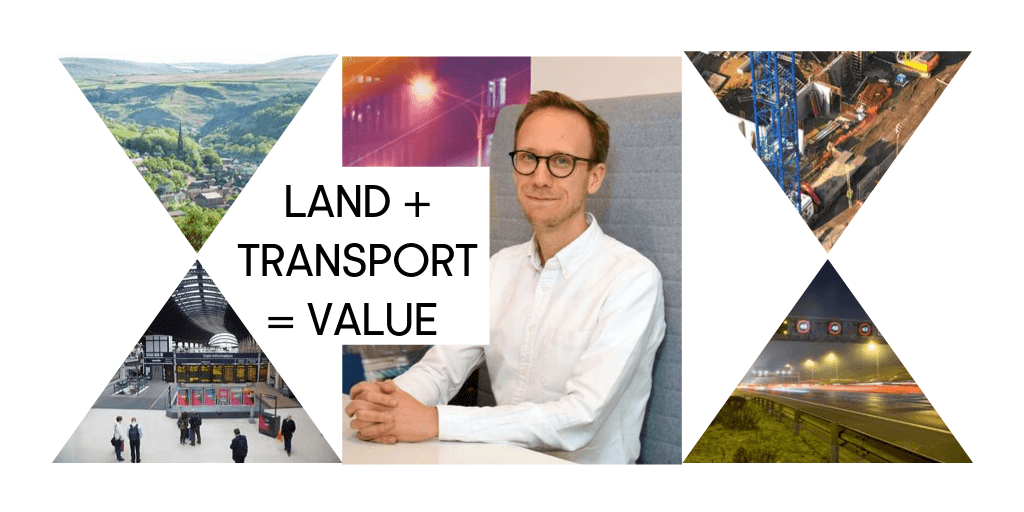Jack Snape, Principal Data Analytics and Modelling Officer at Transport for the North, discusses the link between land value and transport infrastructure.
A couple of months ago I wrote a blog about why we’re developing an Analytical Framework to better understand how transport investment in the North could help rebalance the UK’s spatially imbalanced economy.

One of the key economic reasons to think rebalancing might be a good idea is that the North has substantial assets in terms of water, energy, land and building stock, whereas in London and the South East these types of resources are highly constrained and expensive to expand.
Why are existing buildings and vacant land in the North not used to their full potential? A key explanation is a lack of transport connections in some areas, which can prevent people and businesses relocating to or investing in these places due to a lack of access to jobs and other opportunities.
Last year, we co-funded a team at the Institute for Transport Studies (ITS) at the University of Leeds to carry out some research to quantify the extent to which transport accessibility can make places more attractive to people and businesses. This week, we published the final report from this project, which is available to view online here. It’s a thorough, data-driven piece of work, which has received excellent feedback from experts in the field and forms a crucial part of the evidence base for Transport for the North and our Northern partner Local Authorities.
Key findings include significant impacts from better access to employment by rail, road and walking. This information can be used to help make the case for a variety of transport infrastructure, ranging from inter-city rail connections to local schemes that improve walking and cycling access. To work accurately, the land value model designed by the ITS team needed to represent all the major factors that might explain the values in the land and property market, including ‘place quality’ variables like access to green space and other amenities. This means the evidence could also be used to help make the case for investment in local improvements, such as parks and other green spaces.
One potential challenge to the work is that it measures ‘value’ and ‘attractiveness’ using house prices and commercial rents. You could argue that house prices don’t represent an area’s true value. Also, house prices are already high in historical terms, so should we really be looking for ways to increase them further?
Firstly, all the ways we have of measuring how much people value things are a bit flawed. We either have to ask a large number of people in a survey, which can be expensive and is subject to all kinds of potential bias, or measure how much people are willing to pay for things in a market. Although this price-paid approach could potentially miss some more intangible aspects of true value, it has a reasonably sound theoretical basis for the housing market. Plus, there are lots of freely available data on house prices out there.
Secondly, we need to avoid transport investment simply ‘heating up’ the North’s housing market by ensuring transport plans and spatial planning policy are closely aligned. The real opportunity that arises from an increase in land value in the North is that it should stimulate investment. It should encourage new and refurbished housing in places where people can easily and sustainably commute to work, as well as more high-density employment sites around transport hubs, which are more likely to create higher paid, higher productivity jobs. If planning policy can ensure supply of new housing is built quickly and is diverse enough, it can avoid gentrification pushing people out of regenerated areas.
It’s also important to consider who benefits financially from these potential value increases. In the absence of new policies, it’s likely that there would be windfall gains to landlords and owner-occupiers. Alternative options include forms of Land Value Capture, which allow a proportion of these financial gains to be collected by local or national government and re-invested into transport or other local policies. This is a complex and sensitive policy area and Transport for the North does not have a remit to implement such policies, although this may be something that Transport for the North partner organisations wish to consider as plans for transformational new transport investment are developed. However, based upon our preliminary analysis undertaken as part of the development of the Transport for the North Funding Framework (p26) and set out in Transport for the North’s Strategic Transport Plan (p143 onwards), the role of such local funding sources is assessed as being relatively limited in the context of Transport for the North-led investment.
This new research has provided a robust body of evidence to help us build the case for investment in transport, but we need to take it further over the next few months. A key caveat is that the approach only measures ‘first order’ effects, meaning the calculation assumes people and businesses don’t move in response to a place becoming more attractive. At Transport for the North, we already have a way of simulating how people respond to improvements in transport using our Northern Economy and Land-Use Model (NELUM). We plan to build the new evidence from this study into NELUM in the near future, so we can understand the second and third order ‘dynamic’ effects that are likely to occur when major transport improvements like Northern Powerhouse Rail are built.
Finally, it’s worth adding that this has been a great opportunity for Transport for the North and our partners at West Yorkshire Combined Authority to work collaboratively with academics at ITS Leeds. We’re really keen to continue to build links with academic institutions across the North and the rest of the UK, so please get in touch if you have ideas for how we can use analysis to improve our transport system.